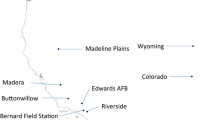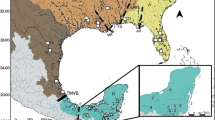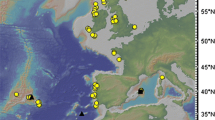Abstract
Townsend’s Shearwater (Puffinus auricularis auricularis) is a highly threatened bird and currently breeds on Socorro and Clarión Islands, México. This subspecies has minor differences in plumage patterns when compared to Newell’s Shearwater of Hawaii (USA) (Puffinus auricularis newelli). These two forms are recognized as subspecies by the American Ornithologist’s Union. However, some authors consider them as distinct species based on subtle plumage differences and different breeding chronologies. We used Bayesian and Maximum Likelihood methods to compare the cytochrome b and cytochrome oxidase I sequences from Townsend’s Shearwaters with archived mitochondrial sequences from other taxa in the genus Puffinus. Townsend’s and Newell’s Shearwaters show little genetic differentiation; hence, there is no justification to consider them as different species. Additionally, differences in morphology and ecology might be the result of founder effects and phenotypic plasticity; proven migratory potential provides support to the current taxonomic assessment that considers these birds as conspecifics. We recommend the continued treatment of Townsend’s and Newell’s Shearwaters as two subspecies of P. auricularis. We also advocate treating the Rapa Shearwater (P. myrtae) as a distinct species.
Zusammenfassung
Stammesgeschichtliche Einordnung des hochgradig gefährdeten Townsendsturmtauchers ( Puffinus auricularis auricularis ): Nachweis für seinen engen Verwandtschaftsgrad zum Newellsturmtaucher ( Puffinus a. newelli ) und für die Diskrepanz zwischen genetischer und phänotypischer Abgrenzung Der Townsendsturmtaucher ist ein hochgradig gefährdeter Vogel, der derzeit noch auf den Socorro und Clarion-Inseln, Mexiko, brütet. Zum Newellsturmtaucher auf Hawaii (USA) zeigt er nur kleine Unterschiede in der Gefiedermusterung; die beiden sind von der Union Amerikanischer Ornithologen als Unterarten anerkannt. Dennoch betrachten einige Autoren sie aufgrund der Unterschiede im Gefieder und in der Brutabfolge als eigenständige Arten. Wir setzten die Maximum Likelihood-Methode der Bayesschen Wahrscheinlichkeitsrechnung ein, um die Cytochrome b- und die Cytochrome Oxidasen I-Sequenzen miteinander zu vergleichen, die wir einerseits vom Townsendsturmtaucher, andererseits von archiviertem mitochondrialem Material anderer Sturmtaucher-Arten gewonnen und sequenziert hatten. Townsend- und Newellsturmtaucher zeigten nur geringe genetische Unterschiede, weswegen es keine Rechtfertigung dafür gibt, sie als eigene Arten anzusehen. Unterschiede in ihrer Morphologie und Ökologie könnten vom sog. „Gründereffekt“und der phänotypischen Plastizität herrühren; das nachgewiesene Wander- und Ausbreitungspotential unterstützen die derzeitige taxonomische Bewertung, dass es sich hier um zwei Unterarten einer Art handelt. Wir empfehlen, Townsend- und Newellsturmtaucher auch weiterhin als zwei Unterarten von (Puffinus auricularis) zu betrachten. Darüber hinaus plädieren wir dafür, den Rapasturmtaucher (Puffinus myrtae) als eine eigene Art anzusehen.


Similar content being viewed by others
References
Ainley DG, Telfer TC, Reynolds MH (1997) Newell’s and Townsend’s Shearwater (Puffinus auricularis). No. 297. In: Poole A, Gill F (eds) The birds of North America. The Academy of Natural Sciences and The American Ornithologists’ Union. Philadelphia, Washington, D.C.
Aleixandre P, Hernández Montoya J, Milá B (2013) Speciation on oceanic islands: rapid adaptive divergence vs. cryptic speciation in a Guadalupe Island songbird (Aves: Junco). PLoS One 8(5):e63242
American Ornithologists’ Union (AOU) (1983) Check-list of North American birds, 6th edn. American Ornithologists’ Union, Washington, D.C.
American Ornithologists’ Union (AOU) (1998) Check-list of North American birds, 7th edn. American Ornithologists’ Union, Washington, D.C.
Anthony AW (1898) Avifauna of the Revillagigedo Islands. Auk 15:311–318
Austin JJ (1996) Molecular phylogenetics of Puffinus shearwaters: preliminary evidence from mitochondrial cytochrome b gene sequences. Mol Phyl Evol 6:77–88
Austin JJ, James J, Pasquet E (2004) A global molecular phylogeny of the small Puffinus shearwaters and implications for systematics of the little-Audubon’s shearwater complex. Auk 121:847–864
Avise JC (2000) Phylogeography: the history and formation of species. Harvard University Press, Chicago 447
Baptista LF, Martínez-Gómez JE (2002) La investigación bioacústica de las aves del Archipiélago de Revillagigedo: un reporte de avance. Huitzil 3:33–41
Barber BR, Martínez-Gómez JE, Peterson AT (2004) Systematic position of the Socorro Mockingbird Mimodes graysoni. J Avian Biol 35:195–198
BirdLife International (2000) Threatened birds of the world. Lynx Edicions and BirdLife International, Barcelona and Cambridge
Bohrson WA, Reid MR (1998) Genesis of evolved ocean island magmas by deep-and shallow-level basement recycling, Socorro Island, Mexico: constraints from Th and other isotope signatures. J Petrol 39:995–1008
Bohrson WA, Reid MR, Grunder AL, Heizler MT, Harrison TM, Lee J (1996) Prolonged history of silicic peralkaline volcanism in the eastern Pacific Ocean. J Geophys Res 101:11457–11474
Bourne WRP, Mackrill EJ, Paterson AM, Ye´sou P (1988) The Yelkouan shearwater Puffinus (puffinus?) yelkouan. Br Birds 81:306–319
Brooke M (1990) The Manx shearwater. T and A D Poyser, London
Brooke M (2004) Albatrosses and petrels across the world. Oxford University Press, Oxford
Bryan W (1966) History and mechanism of eruption of soda rhyolite and alkali basalt, Socorro Island, Mexico. Bull Volcanol 29:453–479
Carboneras C (1992) Family Procellariidae (Petrels and Shearwaters). In: del Hoyo J, Elliott A, Sargatal J (eds) Handbook of the Birds of the World, vol 1. Lynx Edicions, Barcelona
Collar NJ, Gonzaga LP, Krabbe N, Madroño-Nieto A, Naranjo LG, Parker TA III, Wege DC (1992) Threatened birds of the Americas. Smithsonian Institution Press in cooperation with International Council for Bird Preservation, Washington, D.C.
Collar NJ, Crosby MJ, Stattersfield AJ (1994) Birds to watch 2. The world list of threatened birds. Birdlife conservation series No. 4. Birdlife International, Cambridge
Darriba D, Taboada GL, Doallo R, Posada D (2012) jModelTest: more models, new heuristics and parallel computing. Nat Methods 9:772
De Queiroz K (2007) Species concepts and species delimitation. Syst Biol 56:879–886
Del Hoyo J, Elliott A, Sargatal J (2014) Illustrated cheklist of the birds of the world, vol. 1: Non-passerines. Lynx Editions and Birdlife International, p 903
Evans EL, Martínez-Gómez JE, Sehgal RNM (2014) Phylogenetic relationships and taxonomic status of the endemic Socorro Warbler (Setophaga pitiayumi graysoni) J Ornithol
García-Moreno J, Sorenson MD, Mindell DP (2003) Congruent avian phylogenies inferred from mitochondrial and nuclear DNA sequences. J Mol Evol 57:27–37
Genovart M, Oro D, Juste J, Bertorelle G (2007) What genetics tell us about the conservation of the critically endangered Balearic Shearwater? Biol Conserv 137:283–293
Gill FB (2014) Species taxonomy of birds: which null hypothesis? Auk 131:150–161
Gill F, Donsker D (eds) (2014) IOC World Bird List (v 4.3). doi:10.14344/IOC.ML.4.3
Gómez-Díaz E, González-Solís J, Peinado MA, Page RD (2006) Phylogeography of the Calonectris shearwaters using molecular and morphometric data. Mol Phyl Evol 41:322–332
Guindon S, Dufayard JF, Lefort V, Anisimova M, Hordijk W, Gascuel O (2010) New algorithms and methods to estimate maximum-likelihood phylogenies: assessing the performance of PhyML 3.0. Syst Biol 59:307–321
Heidrich P, Amenguala J, Wink M (1998) Phylogenetic relationships in Mediterranean and North Atlantic shearwaters (Aves: Procellariidae) based on nucleotide sequences of mtDNA. Biochem Syst Ecol 26:145–170
Heindl MT, Garret KL (2008) The 32nd report of the California bird records committee: 2006 records. Western Birds 39:121–152
Henshaw HW (1900) Description of a new shearwater from the Hawaiian islands. Auk 17:246–247
Howell SNG (2012) Petrels, albatrosses and storm-petrels of North America. Princeton University Press, New Jersey
Howell SNG, Spear LB, Pyle P (1994) Identification of Manx-type shearwaters in the Eastern Pacific. Western Birds 25:169–177
Huelsenbeck JP, Ronquist F (2001) MRBAYES Bayesian inference of phylogenetic trees. Bioinformatics 17:754–755
Jehl JR (1982) The biology and taxonomy of Townsend’s Shearwater. Gerfaut 72:121–135
Jehl JR, Everett WT (1985) History and status of the avifauna of Isla Guadalupe, Mexico. Trans San Diego Soc Nat Hist 20:313–336
Johnson KP, Clayton DH (2000) A molecular phylogeny of the dove genus Zenaida: mitochondrial and nuclear DNA sequences. Condor 102:864–870
Kerr KC, Stoeckle MY, Dove CJ, Weigt LA, Francis CM, Hebert PD (2007) Comprehensive DNA barcode coverage of North American birds. Mol Ecol Notes 7:535–543
Kocher TD, Thomas WK, Meyer A, Edwards SV, Pääbo S, Villablanca FX, Wilson AC (1989) Dynamics of mitochondrial DNA evolution in animals: amplification and sequencing with conserved primers. Proc Natl Acad Sci USA 86:6196–6200
Koichiro Tamura K, Stecher G, Peterson D, Filipski A, Kumar S (2013) MEGA6: molecular evolutionary genetics analysis version 6.0. Mol Biol Evol 30:2725–2729
Labarthe N, Serrão ML, Melo YF, Oliveira SJ, Lourenço-de-Oliveira R (1998) Potential vectors of Dirofilaria immitis (Leidy, 1856) in Itacoatiara, oceanic region of Niterói municipality, State of Rio de Janeiro, Brazil. Memórias do Instituto Oswaldo Cruz 93:425–432
Librado P, Rozas J (2009) DnasSP v5: A software for comprehensive analysis of DNA polymorphism data. Bioinformatics 25:1451–1452
Lijtmaer DA, Kerr KC, Stoeckle MY, Tubaro PL (2012) DNA barcoding birds: from field collection to data analysis. In: DNA Barcodes. Humana Press, pp 127–152
Lim HC, Chua VL, Benham PM et al (2014) Divergence history of the Rufous-tailed Tailorbird (Orthotomus sericeus) of Sundaland: implications for the biogeography of Palawan and the taxonomy of island species in general. Auk 131:629–642
Lovette IJ, Arbogast BS, Curry RL, Zink RM, Botero CA, Sullivan JP, Talaba AL, Harris RB, Rubenstein DR, Ricklefs RE, Bermingham E (2012) Phylogenetic relationships of the mockingbirds and thrashers (Aves: Mimidae). Mol Phyl Evol 63:219–229
Martínez-Gómez JE, Jacobsen JK (2004) The conservation status of Townsend’s shearwater Puffinus auricularis auricularis. Biol Conserv 116:35–47
Martínez-Gómez JE, Barber B, Peterson AT (2005) Phylogenetic position and generic placement of the Socorro Wren (Thryomanes sissonii). Auk 122:50–56
McKay BD, Reynolds MBJ, Hayes WK, Lee DS (2010) Evidence for the species status of the Bahama Yellow-Throated Warbler (Dendroica “Dominica” flavescens). Auk 127:932–939
McLellan ME (1926) Expedition to the Revillagigedo islands, Mexico, in 1925, VI. Procc Cal Acad Sci Fourth Series 15:279–322
Murphy RC (1952) The Manx shearwater, Puffinus puffinus, as a species of world-wide distribution. Amer Mus Novitates 1586:1–21
Navarro-Sigüenza AG, Peterson AT (2004) An alternative species taxonomy of the birds of Mexico. Biota Neotropica 4(2):1–32 (BN03504022004)
Nunn GB, Stanley SE (1998) Body size effects and rates of cytochrome b evolution in tube-nosed seabirds. Mol Biol Evol 15:1360–1371
Patel S, Waugh J, Millar CD, Lambert DM (2010) Conserved primers for DNA barcoding historical and modern samples from New Zealand and Antarctic birds. Mol Ecol Res 10:431–438
Peterson AT, Navarro-Sigüenza AG (1999) Alternate species concepts as bases for determining priority conservation areas. Conserv Biol 13:427–431
Pratt HD, Bruner PL, Berrett DG (1987) A Field guide to the birds of Hawaii and the tropical Pacific. Princeton University Press, Princeton
Pyle PA, Welch J, Fleisher RC (2011) A new species of shearwater (Puffinus) recorded from Midway Atoll, northwestern Hawaiian Islands. Condor 113:518–527
Rambaut A, Drummond AJ (2013) Tracer v1.6. (tree.bio.ed.ac.uk/software/tracer/)
Ramirez O, Illera JC, Rando JC, Gonzalez-Solis J, Alcover JA, Lalueza-Fox C (2010) Ancient DNA of the extinct lava shearwater (Puffinus olsoni) from the Canary islands reveals incipient differentiation within the P. puffinus complex. PLoS One 5(12):e16072
Rheindt FE, Szekely T, Edwards S, Lee PLM et al (2011) Conflict between genetic and phenotypic differentiation: the evolutionary history of a ‘lost and rediscovered’ shorebird. PLoS One 6(11):e26995
Saitoh T, Sugita N, Someya S, Iwami Y, Kobayashi S, Kamigaichi H, Higuchi A, Asai S, Yamamoto Y, Nishiumi I (2014) DNA barcoding reveals 24 distinct lineages as cryptic bird species candidates in and around the Japanese Archipelago. Mol Ecol Res. doi:10.1111/1755-0998.12282
Schindel DE, Stoeckle MY, Milensky C, Trizna M, Schmidt B, Gebhard C, Graves G (2011) Project description: DNA barcodes of bird species in the national museum of natural history, Smithsonian Institution USA. ZooKeys 152:87
Spear L, Ainley D, Nur N, Howell SGN (1995) Population size and factors affecting at-sea distributions of four endangered procellariids in the tropical Pacific. Condor 97:613–638
Swofford DL (2002) PAUP*. Phylogenetic analysis using parsimony (*and other methods), version 4.0b.10. Sinauer Associates, Sunderland
Tarr CL, Fleischer RC (1993) Mitochondrial-DNA variation and evolutionary relationships in the Amakihi complex. Auk 110:825–831
Templeton AR (2006) Population genetics and microevolutionary theory. Wiley, New York, p 705
Tobias JA, Seddon N, Spottiswoode CN, Pilgrim JD, Fishpool LD, Collar NJ (2010) Quantitative criteria for species delimitation. Ibis 152:724–746
Townsend CH (1890) Scientific results of explorations by the U.S. Fish Commission Steamer Albatross. Proc US Natl Mus 13:131–142
Unitt P, Faulkner MA, Swanson C (2009) First record of Newell’s Shearwater from the mainland of North America. West Birds 40:21–28
Veitch CR (1985) Methods for eradicating feral cats from offshore islands in New Zealand. In: Moors PJ (ed) Conservation of island birds. International Council for Bird Preservation (Technical Publication 3), Cambridge, pp 125–141
Veitch CR (1989) The eradication of cats and sheep from Socorro Island. North Region Technical Report Series. No. 11. Department of Conservation, New Zealand
Weir JT, Schluter D (2008) Calibrating the avian molecular clock. Mol Ecol 17:2321–2328
Wink M, Heidrich P, Ristow D (1993) Genetic evidence for speciation of the Manx Shearwater Puffinus puffinus and Mediterranean shearwater Puffinus yelkouan. Vogelwelt 114:226–232
Acknowledgments
The Mexican Navy provided generous logistical support that allowed the completion of this study; we particularly thank Admiral F. Jiménez Colorado, Captain D. Castro Castro and naval personnel stationed at Socorro and Clarión Islands. We are sincerely grateful to M. J. Navarro Sánchez, Reserve’s acting director of the Revillagigedo Archipelago Biosphere Reserve, and Lieutenant A. Lechuga Medina, at the Naval Oceanographic Institute, for their invaluable field assistance. We sincerely thank the Administration of the Federal Insular Territory for promoting scientific research on Mexican islands. A. Cavazos provided assistance in data analysis. H. Horblit, J. Cervantes Pasqualli, H. Archer, and an anonymous reviewer provided valuable insights on earlier versions of this manuscript. Funding was provided by the Island Endemics Foundation, the American Bird Conservancy, the Mohamed bin Zayed Species Conservation Fund, and the Instituto de Ecología, A.C. (INECOL). This research was conducted under permits DICOPPU/211/2158/10 (SEGOB) and SGPA/DGVS/06778/10 (SEMARNAT) granted to JEMG.
Author information
Authors and Affiliations
Corresponding author
Additional information
Communicated by M. Wink.
Rights and permissions
About this article
Cite this article
Martínez-Gómez, J.E., Matías-Ferrer, N., Sehgal, R.N.M. et al. Phylogenetic placement of the critically endangered Townsend’s Shearwater (Puffinus auricularis auricularis): evidence for its conspecific status with Newell’s Shearwater (Puffinus a. newelli) and a mismatch between genetic and phenotypic differentiation. J Ornithol 156, 1025–1034 (2015). https://doi.org/10.1007/s10336-015-1189-2
Received:
Revised:
Accepted:
Published:
Issue Date:
DOI: https://doi.org/10.1007/s10336-015-1189-2




